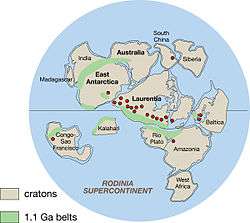SWEAT (hypothesis)
SWEAT stands for southwestern United States and East Antarctica, which theorizes that the Southwestern United States was at one time connected to East Antarctica. A hypothesis for a late Precambrian fit of western North America with the Australia-Antarctic shield region permits the extension of many features through Antarctica and into other parts of Gondwana, specifically, the Grenville orogen may extend around the coast of East Antarctica into India and Australia. The ophiolitic belt of the latter may extend into East Antarctica. The Wopmay orogen of northwest Canada may extend through eastern Australia into Antarctica and thence beneath the ice to connect with the Yavapai-Mazatzal orogens of the southwestern United States. Counterparts of the Precambrian-Paleozoic sedimentary rocks along the U.S. Cordilleran miogeocline may be present in the Transantarctic Mountains. Orogenic belt boundaries provide useful piercing points for Precambrian continental reconstructions. The model implies that Gondwana and Laurentia drifted away from each other on one margin and collided some 300 million years later on their opposite margins to form the Appalachians.[2]
Evidence
A paper published by an international team led by John Goodge, an NSF-funded researcher with the Department of Geological Sciences at the University of Minnesota-Duluth, gives significant support to the theory.[3][4]
Writing in the July 11, 2008 edition of the journal Science, this international team of U.S. and Australian investigators describe their findings, which were made in the Transantarctic Mountains, and their significance to the problem of piecing together what an ancient supercontinent, called Rodinia, looked like. The U.S. investigators were funded by the National Science Foundation (NSF).[4]
Previous lines of scientific evidence led researchers to theorize that about 600-800 million years ago a portion of Rodinia broke away from what is now the southwestern United States and eventually drifted southward to become eastern Antarctica and Australia. They argue that the team's find provides physical evidence that confirms the southwestern United States and East Antarctica (SWEAT) hypothesis.[4]
John Goodge's team was searching in Antarctica's Transantarctic Mountains for rocks carried along by ice rivers that could provide clues to the composition of the underlying crust of Antarctica, which in most places is buried under 2 miles of ice. One rock, found atop the so-called Nimrod Glacier, was later determined to be a very specific form of granite which has a particular type of coarse-grained texture.[4][5] Chemical tests run on the rock revealed that it has a chemistry very similar to a unique belt of igneous rocks in North America that stretch from California through New Mexico to Kansas, Illinois and eventually New Brunswick and Newfoundland in Canada. This belt of rock was a part of what is called Laurentia, thought by some geologists to be the core of Rodinia.This belt stops suddenly at its western margin, leading geologists to suspect that some piece of crust had rifted away from what is now the West Coast of the United States.[4][5][6]
East Antarctica–Laurentia Juxtaposition
The positions of Laurentia and other landmasses in the Precambrian super continent of Rodinia are controversial. Although geological and isotopic data support an East Antarctic fit with western Laurentia, alternative reconstructions favor the juxtaposition of Australia, Siberia, or South China. New geologic, age, and isotopic data provide a positive test of the juxtaposition with East Antarctica: Neodymium isotopes of Neoproterozoic rift-margin strata are similar; hafnium isotopes of about 1.4 billion year old Antarctic-margin detrital zircons match those in Laurentian granites of similar age; and a glacial clast of A-type granite has a uranium-lead zircon age of ~1440 million years, an epsilon-hafnium initial value of +7, and an epsilon-neodymium initial value of +4. These tracers indicate the presence of granites in East Antarctica having the same age, geochemical properties, and isotopic signatures as the distinctive granites in Laurentia.
See also
External links
References
- ↑ "Research paper suggests East Antarctica and North America once linked". The Antarctic Sun (United States Antarctic Program). 26 August 2011. Retrieved 15 November 2012.
- ↑ http://www.geosociety.org/news/pr/01-10.htm
- ↑ Hill, Josh Hill (July 18, 2008). "Were Antarctica and North America Once Connected? A Single Boulder Says "Yes"". The Daily Galaxy. Retrieved 2008-07-29.
- 1 2 3 4 5 "A Single Boulder May Prove that Antarctica and North America Were Once Connected". National Science Foundation. July 17, 2008. Retrieved 2008-07-29.
- 1 2 Thompson, Andrea (July 28, 2008). "Senior Writer". LiveScience.com. Archived from the original on August 13, 2008. Retrieved 2008-07-29.
- ↑ "A Positive Test of East Antarctica–Laurentia Juxtaposition Within the Rodinia Supercontinent". Science. Retrieved 2008-07-29.
| |||||||||||||||||||||||||||||||||

.svg.png)
.svg.png)
.svg.png)
.svg.png)


.svg.png)
.svg.png)
.svg.png)
.svg.png)
.svg.png)